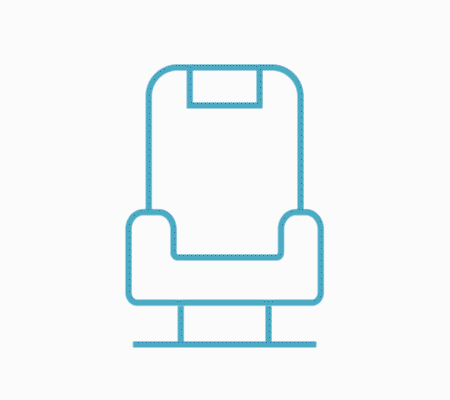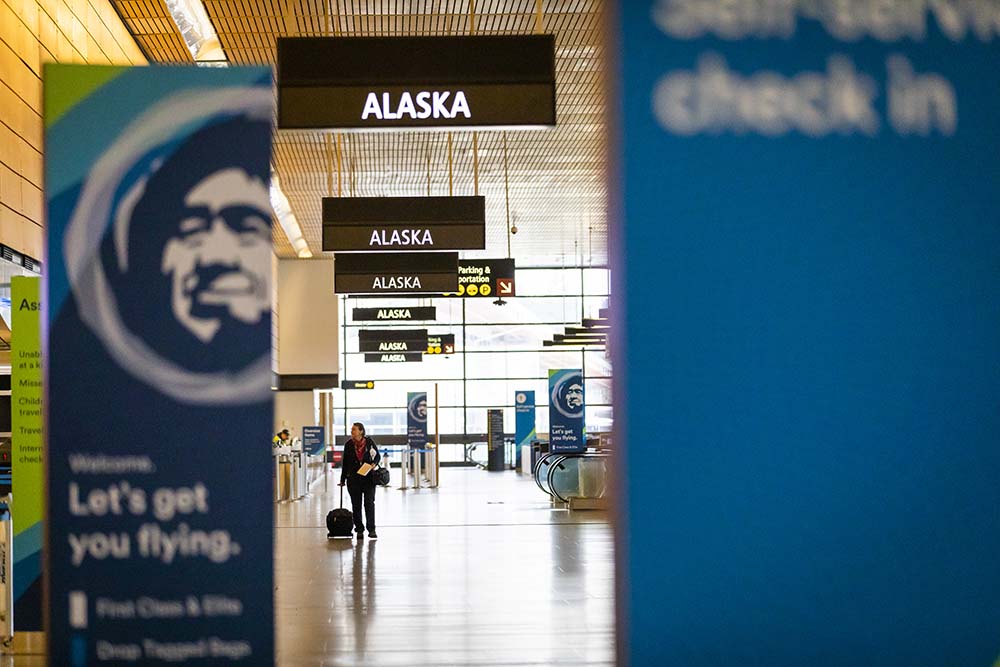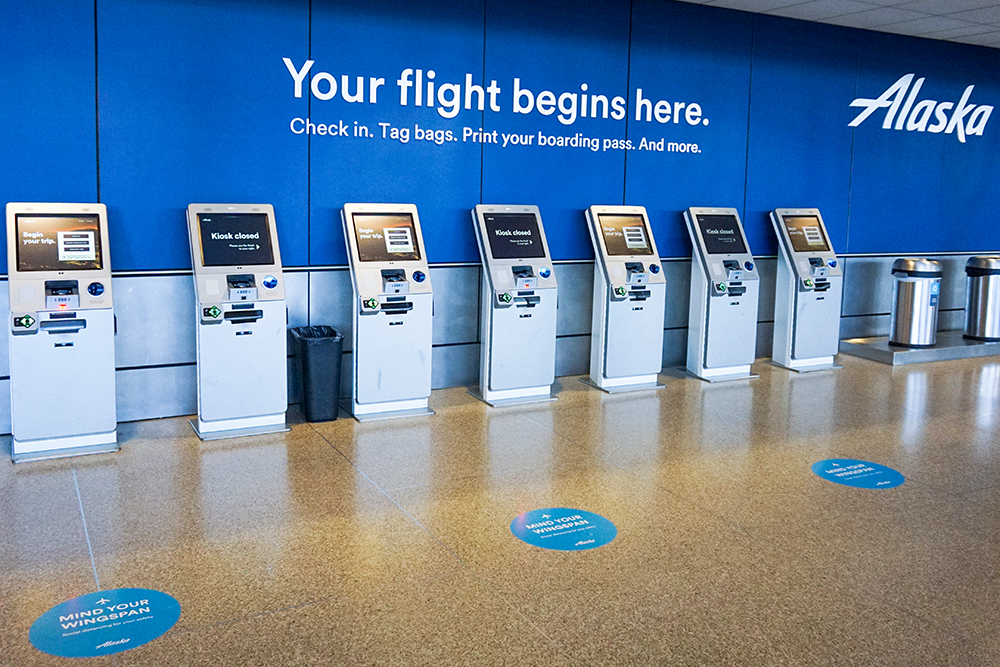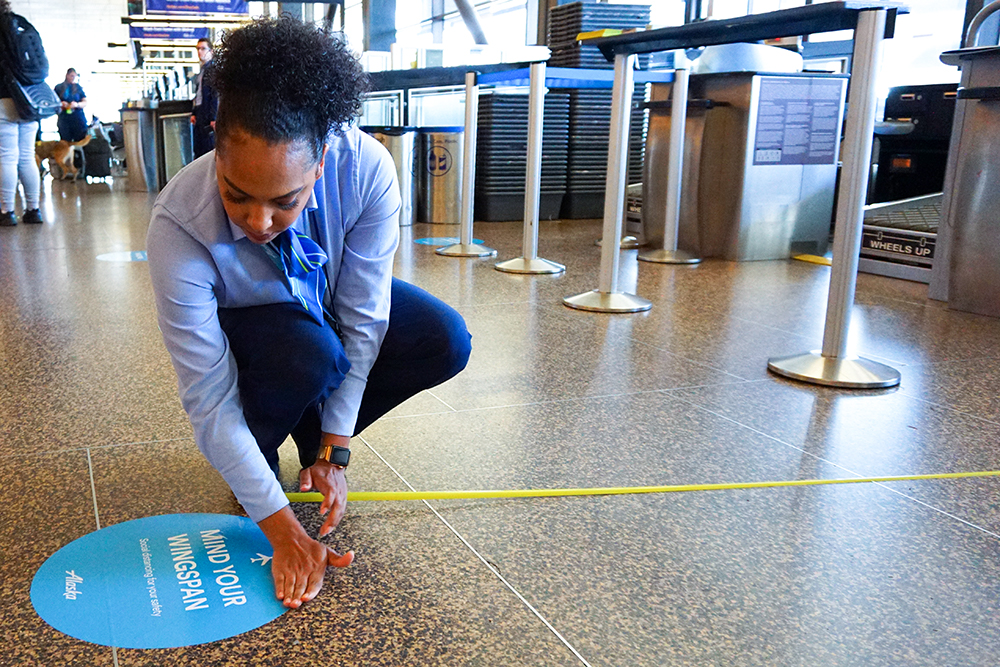Hawaiian Airlines pilots and flight attendants arriving at our Honolulu headquarters for their annual training qualifications are experiencing a new, COVID-conscious classroom environment.
In March, as COVID-19 became a pandemic, we made the difficult but necessary decision to cease most of our flying, put our growth plans on hold and institute a hiring freeze. Without new-hire instruction taking place, we took time to reassess and restructure our crewmember training programs before recently bringing them back.
Supporting Our Flight Attendant Force
After an approximate two-month pause, flight attendant training operations resumed June 1 with an adjusted classroom format that follows health recommendations by the Centers for Disease Control and Prevent (CDC) and the Federal Aviation Administration (FAA).
Ryan Casco, director of instructional delivery at Hawaiian, said his team remains focused on supporting and training over 2,100 flight attendants who continue to safely and confidently welcome guests on essential flights we have been operating in a reduced schedule. Our crewmembers are also looking forward to seeing more guests onboard our Neighbor Island flights starting June 16, when the state of Hawai'i lifts its quarantine restriction for travel between the islands.

A cohort of flight attendants at one of our annual requalification programs at our Honolulu headquarters.
“When we talk about training, we’re really talking more about requalifying our current flight attendants and sustaining that forward movement. After a flight attendant completes new-hire training, they’re required to come in annually to complete requalification training,” Casco said. “If they don’t qualify, they don’t fly, so requalification is what we are fixated on right now.”
“We knew that every training decision we make moving forward would set the precedence for how we do training in the future,” said Casco, whose team spent weeks mapping out what our requalification training would look like amid COVID-19. “What we decided is that we were going to keep training the same, but revamp it with different precautions when going through training that adjusted how we use the equipment, demonstrate certain skills, and utilize personal protective equipment. We want to make sure that the integrity of our safety procedures remains completely intact every step of the way.”

An instructor walks her five students through opening the exit door during an emergency drill in a mock aircraft cabin.
Annual training consists of approximately 22 hours of skills-based learning, including two eight-hour days in the classroom, and a comprehensive distance learning program. Now, trainees must distance themselves by six feet, wear gloves when touching shared training equipment and during hands-on training, and they are encouraged to wear a face mask as they are now required to do so when serving our guests. Instructors wipe down equipment at the end of each lesson, and rigorous cleaning of classrooms and training facilities occurs nightly.
“When flight attendants come in, there are different drills and evacuation commands that they have to perform to ensure they are capable. Through the recurrent training, we are just verifying that our flight attendants are highly qualified safety professionals, and they continue to embody our values. We want to make sure they learn from our instructors how to continue representing aloha, po‘okela (to excel), ho‘okipa (hospitality), lōkahi (unity), mālama (to care for), and our other core Hawaiian values (during and after the pandemic). Seeing these values expressed in real life is critical because our values are what makes us uniquely different,” Casco explained.
Requalification classes of 20 trainees, previously split with two groups with two instructors per group, are now divided into four clusters of five employees, each with one instructor, to allow for proper distancing.

Flight attendants are required to demonstrate several skills during annual requalification. Here, a flight attendant practices opening and closing a cabin door during an emergency exercise.
“Our staffing is still the same. The only thing that has changed is that we needed more classrooms to accommodate the increase in groups,” Casco shared.
Nearly 600 flight attendants are scheduled to receive requalification training this month and in July, with 23 instructors hosting 26 classes, up from 20 classes typically held in two months. While the numbers are likely to decrease after July, we expect another wave of requalification training as flight attendants who took voluntary leave return to work.
Until our operations resume to a new form of normalcy, Casco is glad training has started.
“We have flight attendants who are on the frontline every day, and continuing our training is important because it sends a message. If we require our flight attendants to continue business as usual, we need to support them, train them, answer their questions, and speak to their anxiety level," he said. "We understand it’s important to take time off during the pandemic, but if we require our flight crew to get out there and serve our guests on our aircraft, we should keep going.”
Maintaining Pilot Requirements for the Flight Deck
When our pilot training program revved back up in April, we shifted away from a “growth focus” to emphasize the need to keep our over 850 pilots up to date on FAA requirements.
Hawaiian’s pilot training has always been sophisticated. Pilots go through a multi-phased process unique to each candidate’s skill sets, requiring a high level of proficiency and a strong portfolio of prior training before operating an aircraft with Pualani on the tail. Instructional options vary, from long course training – a six-to-eight-week curriculum for fleet transitions, rank promotions, and new hires – to annual, continuing qualification training, which ensures our pilots are compliant with federal regulations. But once the pandemic struck, things became more complicated.

Our parked aircraft lined up on the runway at Honolulu's Daniel K. Inouye International Airport.
“At the start of COVID-19, we were in an expansion phase. We were transitioning a lot of pilots from one fleet type to another, taking aircraft deliveries, launching new routes, and cycling through retirements and new hires,” said Brian Beres, senior director of flight standards and qualifications at Hawaiian. “In April, we had to assess what our priorities were, and that was keeping our existing pilots current. We had to pause for the rest of the pilot group who were training for a fleet upgrade or transition.”
“What gave us the ability to shift our focus on keeping pilots current were exemptions from the FAA, with the help of the Air Line Pilots Association International and Airlines for America,” Beres explained, noting other U.S carriers experienced similar challenges. “The FAA granted us temporary relief to certain regulatory requirements, so we were able to delay when those events needed to occur.” In addition to meeting continuing qualification training with technical skill demonstrations, pilots also need to fulfill minimum flying frequency, or “landing currency.”
“The FAA requires three takeoffs and landings every 90 days per pilot, which is normally not too much of a challenge,” Beres said. “But now we’re in an unprecedented situation where there is a large portion of our pilot group who may be qualified from a continuing qualification standpoint but lack the landing currency because our planes just aren’t flying. We have a more-than-90-percent reduction in flying, but we have the same number of pilots. We hope that this is a temporary situation, but the challenge is maintaining both the continuing qualification and the landing currency.”
To work around the challenge of having most of our fleet grounded, our Airbus A330 and A321neo pilots are temporarily completing landing currency training in our in-house flight simulators (SIM). Beres noted that SIM landings are part of the FAA’s approved methods to maintain landing currency, though the shift from the active cockpit to simulation training limits the number of pilots who can be trained. We currently have about 50 pilots flying each day, compared to some 217 pilots before COVID-19, and our SIM facility can accomodate 15-20 pilots each day for training.

Classroom sizes have been reduced to allow for social distancing, and instructors and pilots are asked to wear masks when gathering for a lesson in our conference rooms.
“It’s definitely a wrinkle that we don’t normally have to contend with,” Beres said.
For our Boeing 717 pilots, he added, the problem isn’t as significant.
“Fortunately, there are more landings to go around on the 717 than on the other aircraft types since we still have Neighbor Island fights that are operating, so it’s less of a challenge," he said. "However, we do have to make sure pilots who need their landing experience get swapped into active line flying trips so we can keep them current. We’re able to do that through crew scheduling to make sure we keep rotating through pilots on those flights.”

One of our Boeing 717 aircraft waiting for takeoff in Honolulu.
In the classroom and simulators, trainees must also follow a new set of requirements based on state and CDC recommendations. We reduced class sizes from 20 or more to ten or fewer pilots to allow for social distancing, provide trainees and trainers with masks, and perform an enhanced cleaning throughout the facility every day. Classroom and training devices are equipped with cleaning kits for crew members and SIM technicians to wipe down hi-touch surfaces between sessions.
Beres says our pilot force remains proficient at the highest level and ready to welcome back more guests as travel restrictions ease.
“Proficiency is usually natural and something you don’t need to worry about, so we had to adjust our focus since 90 percent of our flying has pretty much vanished. And it’s not just Hawaiian Airlines; it’s the entire industry,” he said. “Having state-of-the-art training facilities allow our pilots to log their hours and sharpen their skills as we hopefully begin to bring more of our routes back online in the coming weeks and months.”






















 If you’re still having issues uploading a background, please visit the
If you’re still having issues uploading a background, please visit the 





 Cleanliness has always been important to us, but the next level involves techniques that reduce the already low risk of onboard transmission.
Cleanliness has always been important to us, but the next level involves techniques that reduce the already low risk of onboard transmission.

















 “This month is a very special time where we get the chance to share our culture with the rest of the world. Tonga is known for being the friendliest island and so I’d like to keep that spirit alive whether I’m at work, home or out running errands. Be a light wherever you go.” — Ila Langi, a customer service agent in San Jose California
“This month is a very special time where we get the chance to share our culture with the rest of the world. Tonga is known for being the friendliest island and so I’d like to keep that spirit alive whether I’m at work, home or out running errands. Be a light wherever you go.” — Ila Langi, a customer service agent in San Jose California “This month has become a little more meaningful to me than it has in the past because I have finally taken initiative the past couple months to expand more on what I know of my culture. Especially being married to my husband, who knows the language and culture almost so fluently, he has helped me so much. He’s so encouraging and he makes it so enjoyable to learn and love our culture!” — Angelica Mapa, a customer service agent in San Jose California “Every day, I always try to make it a habit to pass on my knowledge to the younger generation in my family by trying to speak as much Tongan in the home and teach them traditions that we still hold on to today. At work, I always try to answer questions about my culture and heritage to anyone that asks. I always admire my coworkers who openly share what traditional foods they love to make or traditional events they keep up with their family because it also encourages me to share mine as well. It’s always a safe place to share about our heritage at work because no one judges,” she said.
“This month has become a little more meaningful to me than it has in the past because I have finally taken initiative the past couple months to expand more on what I know of my culture. Especially being married to my husband, who knows the language and culture almost so fluently, he has helped me so much. He’s so encouraging and he makes it so enjoyable to learn and love our culture!” — Angelica Mapa, a customer service agent in San Jose California “Every day, I always try to make it a habit to pass on my knowledge to the younger generation in my family by trying to speak as much Tongan in the home and teach them traditions that we still hold on to today. At work, I always try to answer questions about my culture and heritage to anyone that asks. I always admire my coworkers who openly share what traditional foods they love to make or traditional events they keep up with their family because it also encourages me to share mine as well. It’s always a safe place to share about our heritage at work because no one judges,” she said. “This month means so much to me because not only does API month highlight my culture, it allows me to honor the generations before me that have paved the way for me, by their sacrifices and hard work. I am so blessed to have grown up in a multilingual household, and speaking multiple languages helps me stay connected to my heritage.” — Daniel Remigio, Seattle-based flight attendant
“This month means so much to me because not only does API month highlight my culture, it allows me to honor the generations before me that have paved the way for me, by their sacrifices and hard work. I am so blessed to have grown up in a multilingual household, and speaking multiple languages helps me stay connected to my heritage.” — Daniel Remigio, Seattle-based flight attendant “When most people think of Polynesians, they usually think of song and dance, and rightfully so, as it is the root of our culture. Dating back thousands of years, singing and dancing has been an ancient tradition used to communicate and connect, from ceremonial rituals to preparing for war to reciting history through storytelling and more. And although hula might be one of the first types of dance that comes to mind, there are actually many forms of ancient melodic traditions from around the South Pacific, like Samoa, Tonga, New Zealand, Fiji and Tahiti. But no matter which island or country, we all share that same heartbeat of Polynesia through dance.” — Shanyn Wright, multimedia communications specialist
“When most people think of Polynesians, they usually think of song and dance, and rightfully so, as it is the root of our culture. Dating back thousands of years, singing and dancing has been an ancient tradition used to communicate and connect, from ceremonial rituals to preparing for war to reciting history through storytelling and more. And although hula might be one of the first types of dance that comes to mind, there are actually many forms of ancient melodic traditions from around the South Pacific, like Samoa, Tonga, New Zealand, Fiji and Tahiti. But no matter which island or country, we all share that same heartbeat of Polynesia through dance.” — Shanyn Wright, multimedia communications specialist










 Not only can living herbs bring out so many flavors, but they can also be used as disinfectants and natural remedies for health and wellness. Pair sage with water with a little alcohol to make your very own natural disinfectant that smells wonderful, says Buehler.
Not only can living herbs bring out so many flavors, but they can also be used as disinfectants and natural remedies for health and wellness. Pair sage with water with a little alcohol to make your very own natural disinfectant that smells wonderful, says Buehler.





